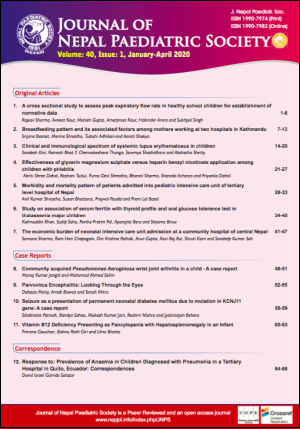Response to: Prevalence of Anaemia in Children Diagnosed with Pneumonia in a Tertiary Hospital in Quito, Ecuador: Correspondence
DOI:
https://doi.org/10.3126/jnps.v40i1.29062Keywords:
Anaemia, Ecuador, Paediatrics, PneumoniaAbstract
Dear editor,
This letter is in response to Chaudhary, Shrestha, and Pathak, who highlighted various aspects of our previous manuscript "Prevalence of Anaemia in Children Diagnosed with Pneumonia in a Tertiary Hospital in Quito, Ecuador." I want to respond to each point referred to in a similar extension as used by the authors.
We agreed on the fact that it is prompt to conclude in nutritional deficiencies as a risk factor to suffer pneumonia in Ecuadorian children that is why we express this conclusion as a possibility. Nevertheless, as evidenced in the meta-analysis presented by Jackson et al., the Odds Ratio (OR) meta-estimate for under nutrition as a risk factor for acute lower respiratory infections was 4.5 (95% CI 2.1-9.5)1. To add, in the same paper, the OR meta-estimate for anaemia, vitamin D deficiency, and zinc supplementation, was 3.9 (95% CI 2.4-6.3), 7.3 (95% CI 2.5 to 21.5), and 0.5 (95% CI 0.3 to 0.9), respectively 1.
Moreover, in a study conducted in Malawi including 9 533 children, severe malnutrition and moderate malnutrition were associated not only with a pneumonia risk but with an increased risk of inpatient mortality, with Odds Ratios (OR) of 4.63 (3.08, 6.97) and 1.73 (1.21, 2.48) respectively. Therefore, there is supporting evidence globally of the suggested risk 2.
I am glad that the authors in the letter bring to the table a discussion of pneumonia diagnosis. In our study, the evaluation of pneumonia started with the clinical assessment including parameters with an acceptable sensitivity (Sen%) or specificity (Spe%), such as; fever on examination (Sen% 47, Spe% 68), history of fever (Sen% 92, Spe% 21), tachypnoea (Sen% 13, Spe% 95), rhonchi (Sen% 26, Spe% 98), crackles (Sen% 43, Spe% 73), wheezing (Sen% 4, Spe% 98) (3). However, as referred to in the original paper, the evaluation was not limited to these factors "Hypoxemia, defined as a sustained saturation of peripheral oxygen (SpO2) <90 %, was used as criteria for hospitalization, along with criteria for respiratory distress, which includes: tachypnoea, dyspnoea, retractions (suprasternal, intercostal, or subcostal), grunting, nasal flaring, apnoea and altered mental status. Furthermore, CBC, acute-phase reactants and chest radiography were performed" (4). Nonetheless, I should remark two factors; firstly, pneumonia severity assessment is based on clinical parameters as presented in the New South Wales Government guideline (5). So, minimizing the utility of the clinical evaluation may be a mistake, especially in institutions without prompt access to the radiologic test. Secondly, even we knew that the patients included in this study were evaluated in other differential diagnoses like bronchiolitis, asthma or cardiac diseases which can mimic pneumonia, this was a cross-sectional study using retrospective data collection.
Regarding the exclusion criteria, concomitant conditions that could affect anthropometric measurements include any congenital disease, which compromises a normal growth independently of the nutritional intake (Examples; Down syndrome, achondroplasia). Conditions that could affect the haemoglobin measurement or other parameters in the complete blood count include haematological, infectious or any disease which physiopathology may influence the interpretation of these results in the context of our study (Examples; Sickle cell disease, thalassemia, haemolytic anaemia, solid tumour cancers, haematological neoplasm, paludism), and conditions that could predispose to pneumonia include diseases which may produce an increased risk of infections (Examples; haematological neoplasm, inherited and acquired immunodeficiencies, immunosuppressive therapy)
It is true that without specific evaluation of iron profile is not possible to establish with a high certainty iron deficiency. However, in our study are some relevant considerations; we excluded patients with a current diagnosis of other types of anaemia (haemolytic anaemia), chronic inflammatory conditions, cancer, and haematological neoplasms. All these factors reduce the possible causes of anaemia, and in the light that nutritional anaemia is the most frequent type in Latin America, it is reasonable to think that iron deficiency may be the leading cause in our patients. When we think about microcytic anaemia, as this was the most frequent type in our study, and as we excluded thalassemia, chronic inflammatory disease, and was no evidence of lead poisoning or newly diagnosed thalassemia in our patients, the possibility of iron deficiency increases. Although, at the end of our paper, we recommend the use of iron profile in new studies. I should highlight that we did not report cases of macrocytic anaemia.
The question regarding the use of nutritional supplements is interesting, especially considering that in Ecuador, the governmental normative of micronutrients supplementation with the product "Chis Paz" consider children between 6 and 24 months of age. In our study, there was no possibility to know if the patients receive any supplementation. But, it would be useful to include this variable in prospective studies.
Subclinical infections and iron deficiency anaemia have been described extensively in subclinical malaria, in other types of subclinical infections and even acute infections, there are still debate.
Downloads
Downloads
Published
How to Cite
Issue
Section
License
Authors who publish with this journal agree to the following terms:
Authors retain copyright and grant the journal right of first publication with the work simultaneously licensed under a Creative Commons Attribution License that allows others to share the work with an acknowledgement of the work's authorship and initial publication in this journal.
Authors are able to enter into separate, additional contractual arrangements for the non-exclusive distribution of the journal's published version of the work (e.g., post it to an institutional repository or publish it in a book), with an acknowledgement of its initial publication in this journal.
Authors are permitted and encouraged to post their work online (e.g., in institutional repositories or on their website) prior to and during the submission process, as it can lead to productive exchanges, as well as earlier and greater citation of published work (See The Effect of Open Access).



